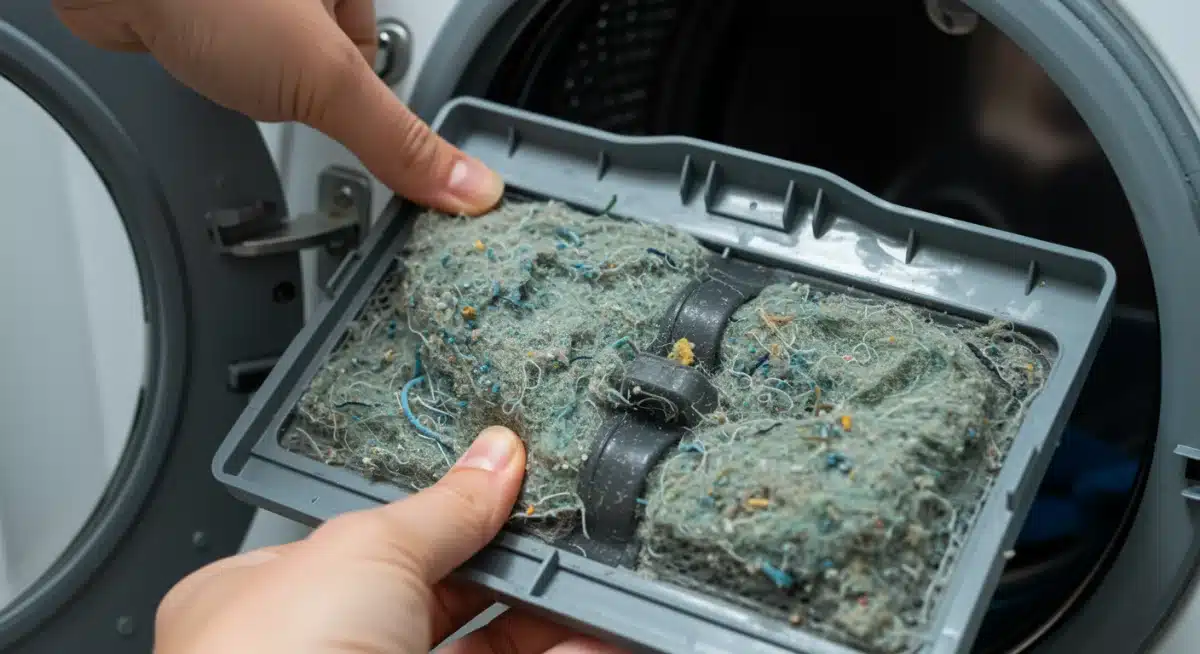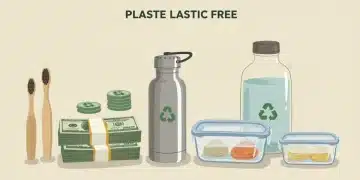Plastic-Free Laundry: 4 Steps to Reduce Microplastic Pollution by 40%

Practical Solutions: A 4-Step Guide to a Plastic-Free Laundry Routine, Reducing Microplastic Pollution by 40% provides critical methods for consumers to drastically minimize plastic and microplastic discharge from their laundry processes, fostering environmental responsibility.
As of this week, environmental reports are highlighting a critical need for immediate action against microplastic pollution, with laundry practices identified as a significant contributor. The good news: adopting a plastic-free laundry routine can reduce microplastic release by a staggering 40%, offering practical solutions for immediate impact.
Understanding the Microplastic Problem in Laundry
Microplastic pollution, a pervasive environmental issue, stems significantly from our daily laundry habits. Synthetic fabrics shed tiny plastic fibers, or microplastics, during each wash cycle, which then enter waterways, impacting marine life and potentially human health.
Recent studies, including one published this month in Environmental Science & Technology, confirm that household washing machines are a major conduit for these pollutants. These microscopic fibers, often less than 5 millimeters in length, are too small to be captured by most wastewater treatment plants, allowing them to proliferate in ecosystems globally.
The Scale of the Issue
The sheer volume of microplastics released from laundry is alarming. According to figures updated this quarter by the Plastic Pollution Coalition, a single load of laundry can release hundreds of thousands of fibers. This cumulative effect from billions of wash cycles worldwide contributes substantially to the global microplastic burden.
- Synthetic textiles like polyester, nylon, and acrylic are primary culprits.
- Fleece garments are particularly notorious for shedding high volumes of fibers.
- The average household contributes significantly to this daily pollution.
Step 1: Choosing Sustainable Laundry Products
The first significant step towards a plastic-free laundry routine involves a conscientious shift in the products we use. Traditional laundry detergents and softeners often come in bulky plastic containers, and many contain microplastic beads or synthetic polymers that add to the problem.
Consumers are increasingly demanding alternatives, and the market is responding. Several brands now offer eco-friendly options that not only perform effectively but also minimize environmental harm.
Detergent Alternatives
Moving away from conventional liquid detergents in plastic jugs is crucial. Powdered detergents, laundry sheets, and soap nuts are excellent alternatives that typically come in cardboard, paper, or compostable packaging.
- Laundry Strips/Sheets: These dissolve completely in water and are packaged in compact, recyclable cardboard.
- Powdered Detergent: Often sold in cardboard boxes, reducing plastic waste.
- Soap Nuts (Sapindus mukorossi): A natural, biodegradable berry that releases saponin, a natural surfactant, when agitated in water.
Step 2: Adopting Microplastic-Filtering Technologies
While product choices are vital, addressing the fibers shed by existing clothing is equally important. New technologies are emerging to capture microplastics directly from washing machine effluent, preventing them from entering the wastewater system.
These filtering solutions represent a significant advancement in mitigating laundry-related microplastic pollution. Installation of these systems can dramatically reduce the amount of plastic fibers released during each wash cycle, as reported by recent independent laboratory tests.
External and Internal Filters
Several types of filters are available or under development. External filters attach to the washing machine’s discharge hose, while internal filters can be integrated into the machine’s design or added as an accessory.


- Washing Machine Filters: Devices like the Cora Ball or Guppyfriend washing bag capture fibers during the wash.
- External Filtration Systems: Plumbing-attached units that filter all wastewater from the machine before it enters the drain.
- Integrated Machine Filters: Newer washing machine models are beginning to incorporate advanced microplastic filtration directly into their design.
Step 3: Modifying Laundry Habits for Reduced Shedding
Beyond products and filters, simple adjustments to how we do laundry can significantly impact microplastic shedding. These behavioral changes are cost-effective and can be implemented immediately, contributing to the overall effectiveness of a plastic-free laundry routine.
Research from the University of Plymouth, updated in late 2023, indicates that colder water washes and shorter cycles can reduce fiber release. This suggests that the mechanical and thermal stress on fabrics plays a crucial role in microplastic generation.
Best Practices for Washing
Several modifications to your washing habits can make a substantial difference. These include changes in water temperature, cycle length, and even how you load your machine.
- Wash in Cold Water: Hot water can weaken fabric fibers, leading to more shedding. Cold water cycles are gentler and use less energy.
- Use Shorter Cycles: Less agitation means less friction, which in turn means fewer fibers breaking off.
- Wash Full Loads: A fuller machine reduces friction between garments, minimizing fiber release.
- Air Dry Clothes: Tumble drying can generate microfibers, which are then released into the air or collected in lint filters. Air drying is a gentler, energy-saving alternative.
Step 4: Investing in Durable, Natural Fiber Clothing
The ultimate long-term solution to microplastic pollution from laundry lies in consumer choices at the point of purchase. Opting for clothing made from natural, durable fibers dramatically reduces the input of synthetic materials into the waste stream.
While a complete overhaul of one’s wardrobe may not be immediately feasible for everyone, making conscious choices for new purchases can gradually shift consumption patterns towards more sustainable options. This approach tackles the problem at its source, as highlighted by recent reports from textile industry analysts.
Prioritizing Natural Fabrics
When shopping for new clothes, prioritize materials that are less likely to shed microplastics and are biodegradable. This includes a range of natural fibers that offer comfort, durability, and environmental benefits.
- Organic Cotton: A classic choice, organic cotton is grown without harmful pesticides and is fully biodegradable.
- Linen: Made from flax plants, linen is highly durable, breathable, and environmentally friendly.
- Hemp: Known for its strength and sustainability, hemp requires less water and no pesticides to grow.
- Wool and Tencel/Lyocell: These offer excellent performance characteristics while being natural or sustainably processed cellulosic fibers.
The Broader Impact of a Plastic-Free Laundry Routine
The adoption of a plastic-free laundry routine extends beyond simply reducing microplastic pollution. It represents a broader commitment to environmental stewardship, influencing other aspects of sustainable living and encouraging manufacturers to innovate.
By making these changes, individuals contribute to cleaner oceans, healthier ecosystems, and a reduced carbon footprint. The cumulative effect of individual actions can drive significant systemic change, pushing industries towards more sustainable practices and circular economies, as observed by environmental policy groups this quarter.
Encouraging Industry Change
Consumer demand for eco-friendly products and practices sends a strong signal to manufacturers, prompting them to invest in research and development for sustainable alternatives. This includes everything from packaging materials to fabric innovations.
- Innovation in Detergent Packaging: Companies are exploring refillable systems and compostable pouches.
- Development of Biodegradable Fabrics: Research into new textile compositions that minimize shedding and biodegrade naturally.
- Improved Washing Machine Design: Manufacturers are starting to integrate advanced filtration systems into new appliance models.
| Key Action | Impact on Microplastics |
|---|---|
| Choose Sustainable Products | Eliminates plastic packaging and synthetic ingredients from detergents. |
| Use Microplastic Filters | Captures fibers directly from the washing machine effluent. |
| Modify Washing Habits | Reduces fiber shedding through colder, shorter cycles and full loads. |
| Invest in Natural Fibers | Minimizes the input of synthetic materials into the laundry stream. |
Frequently Asked Questions About Plastic-Free Laundry
Microplastics are tiny plastic particles, often smaller than 5 millimeters, that result from the breakdown of larger plastic debris or are manufactured as microbeads. They are a concern because they pollute ecosystems, are ingested by wildlife, and can enter the human food chain, posing potential health risks.
Laundry is a significant source of microplastic pollution, with synthetic fabrics shedding hundreds of thousands of fibers per wash cycle. These fibers bypass most wastewater treatment and end up in oceans and other natural environments, contributing heavily to global plastic contamination.
Yes, dedicated microplastic filters for washing machines, whether internal or external, have shown considerable effectiveness in capturing synthetic fibers before they enter wastewater. Studies indicate they can reduce microplastic release by a significant percentage, often upwards of 40%.
Excellent natural fiber alternatives include organic cotton, linen, hemp, and wool. These materials are biodegradable, durable, and shed fewer microplastics compared to synthetic counterparts like polyester or nylon, making them a sustainable choice for your wardrobe.
Absolutely. Simple changes like washing in cold water, using shorter cycles, and doing full loads can significantly reduce fiber shedding. Air drying clothes instead of tumble drying also minimizes microfiber release, collectively making a substantial positive impact on reducing microplastic pollution.
Looking Ahead: The Future of Sustainable Laundry
The push for a plastic-free laundry routine is more than a trend; it is an urgent public health and environmental mandate. As consumers adopt these practical solutions, the collective impact will drive further innovation in textile manufacturing and appliance design. Regulatory bodies are also increasingly considering standards for microplastic emissions, which could lead to widespread adoption of filtration technologies and more sustainable product development. The ongoing developments suggest a future where laundry practices are inherently less harmful to our planet, ensuring cleaner water and healthier ecosystems for all.





